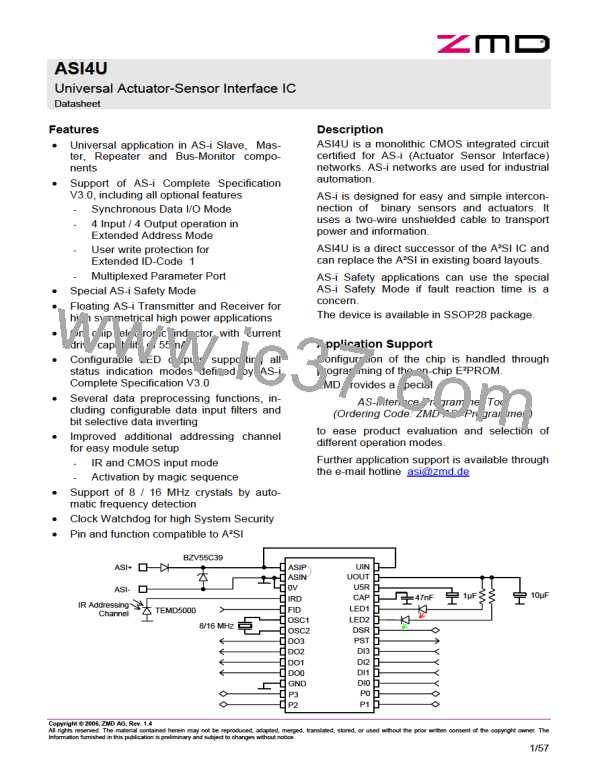ZENTRUM MIKROELEKTRONIK DRESDEN AG
“ASI for you” IC
Datasheet
3.7.7 Master-, Repeater-, Monitor Mode
In Master-, Repeater- and Monitor Mode the data input and data output ports are differently configured than in
Slave Mode. Following control signals are provided at the data input port in Master-, Repeater- and Monitor
Mode:
Table 24: Control signal inputs in Master-, Repeater- and Monitor Mode
Data Input Port
Signal Name
invert_ird_a
invert_ird_b
invert_led1_a
invert_led1_b
Description
DI0
DI1
DI2
DI3
If the signals invert_ird_a and invert_ird_b are unequal, the IRD in-
put signal is inverted before further processing. See Table 13.
If the signals invert_led1_a and invert_led1_b are unequal, the LED1
output signal is inverted after processing. See Table 28.
Note: The complemented definition was chosen to retain backward compatibility to A²SI based AS-i Master de-
signs.
The Data Output Port is exclusively used in Monitor Mode to provide additional UART error signals. The signals
are defined active low and will be set immediately after a telegram error was detected. They become reset at
the beginning of the next telegram. Following signals are available:
Table 25: Error signal outputs in Monitor Mode
Data Port Output UART Error Sig- Description
nal
DO0
plscod_err
Pulse Code Error
Indicates faulty AS-i pulses. This is a disjunc-
tion of alternation error, start bit error, end bit
error
DO1
no_info_err
No Information Error The output signal is a disjunction of No_Infor-
mation_Error and Length_Error as defined in
Length Error
the Complete Spec 3.0.
The Monitor Mode does not distinguish be-
tween synchronized and not synchronized
UART Mode. There is always only one bit
time supervised after the end of a telegram.
DO2
DO3
parb_err
Parity Bit Error
Received parity bit does not match the check
sum calculated by the UART
ird_man_err
Man-II-Code Error at Signal at IRD input violates MAN-II-Coding
rules
IRD input
3.7.8 Special function of DSR
Besides of its standard output function the Data Strobe Pin serves as external reset input for all operational
modes of the IC. Pulling the DSR pin LOW for more than a minimum reset time generates an unconditioned
reset of the IC, which is immediately followed by an re-initialization of the IC (E²PROM read out).
Further information on the IC reset behavior, especially in regard to the signal timing, can be found at chapter
3.11 IC Reset.
Copyright © 2006, ZMD AG, Rev.1.4
All rights reserved. The material contained herein may not be reproduced, adapted, merged, translated, stored, or used without the prior written consent of the copyright owner. The
Information furnished in this publication is preliminary and subject to changes without notice.
38/57

 ZMD [ Zentrum Mikroelektronik Dresden AG ]
ZMD [ Zentrum Mikroelektronik Dresden AG ]